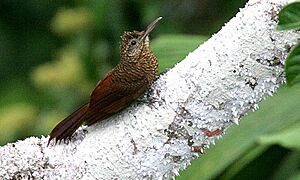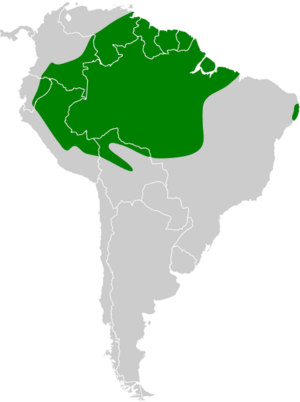Amazonian barred woodcreeper facts for kids
Quick facts for kids Amazonian barred woodcreeper |
|
|---|---|
 |
|
| Sacha Lodge, Ecuador | |
| Conservation status | |
| Scientific classification | |
| Genus: |
Dendrocolaptes
|
| Species: |
certhia
|
 |
|
The Amazonian barred woodcreeper (Dendrocolaptes certhia) is a cool bird that lives in the Amazon Basin. It's a type of passerine bird, which means it's a perching bird, and it belongs to the ovenbird family called Furnariidae. You can find this bird in many South American countries like Bolivia, Brazil, Colombia, Ecuador, French Guiana, Guyana, Peru, Suriname, and Venezuela.
Contents
About Its Name
The Amazonian barred woodcreeper got its scientific name, Dendrocolaptes certhia, a long time ago. The first part, Dendrocolaptes, comes from an Ancient Greek word that means "woodpecker". This makes sense because woodcreepers often climb trees like woodpeckers do! The second part, certhia, is also from an Ancient Greek word for a small bird that eats insects.
Scientists sometimes group animals into different types called subspecies. Think of it like different breeds of dogs, but for wild animals. For the Amazonian barred woodcreeper, there are about seven or eight recognized subspecies. These different groups might have slight differences in their looks or where they live.
What It Looks Like
The Amazonian barred woodcreeper is one of the bigger birds in its family. It's quite slim with a long tail. It has a medium-sized bill that's mostly straight but has a small hook at the end. Males even have a shaggy crest of feathers on their head!
These birds are about 26 to 28.5 cm (10 to 11 in) long. Males usually weigh between 50 to 73.5 g (1.8 to 2.6 oz), and females are a bit heavier, weighing 52 to 79 g (1.8 to 2.8 oz). Both male and female birds look very similar.
Feather Colors
Most Amazonian barred woodcreepers have a brownish face with thin bars. Their forehead and crown (the top of their head) are dark olive-brown, with some golden streaks on the crown. Their back and wing feathers are a lighter olive-brown with faint blackish bars. Their flight feathers and tail are a pretty cinnamon-red to reddish-brown color.
Their chin and throat are pale gray or dirty white, which stands out against their buff-colored underparts. These underparts also have fine dark bars. Their eyes can be reddish or dark brown, and their bill is usually dark red or brownish. Their legs and feet can be brown, green, gray, olive, or black. Young birds look similar to adults but have less clear barring and a shorter, darker bill.
Different subspecies might have slightly different colors or patterns. For example, some might be richer in color, have stronger barring, or even have very little barring at all.
Where It Lives and Its Home
The Amazonian barred woodcreeper lives mainly in the Amazon Basin. It loves humid evergreen forests, especially mature terra firme forests, which are forests on high ground that don't flood. However, you can also find it in forests that get flooded. Sometimes, it lives in savanna forests, mangrove swamps, or even forests that lose their leaves in certain seasons.
This bird is most common deep inside untouched forests. But it can also be seen at the edges of forests and in older secondary forests (forests that have grown back after being cut down). It usually lives from sea level up to about 900 m (3,000 ft) high. In some mountain areas, it can be found as high as 1,400 m (4,600 ft).
How It Behaves
Staying in One Place
The Amazonian barred woodcreeper stays in the same area all year round. It doesn't migrate to other places.
What It Eats
This woodcreeper is a clever hunter! It often forages alone, but it also joins mixed-species feeding flocks with other bird species. This helps them find food together. One of the most interesting ways it finds food is by following army ant swarms. These ants march in huge groups and disturb insects and other small creatures as they move. The woodcreeper then swoops in to catch the prey that the ants scare up!
When following ants, the bird usually perches on a tree trunk and makes short flights to grab prey from leaves, the ground, or vines. When it's not following ants, it flies from a perch to catch food from leaves or tree trunks. Its diet mainly consists of arthropods like insects, spiders, centipedes, and caterpillars. It also eats small vertebrates, such as lizards.
Family Life
Amazonian barred woodcreepers stay paired up throughout the year. Their breeding season can be quite long, sometimes lasting up to 10 months, depending on the area. They build their nests in tree cavities, which can be natural holes or old holes made by woodpeckers.
So far, only one egg has been observed in a nest at a time. Both parents seem to take care of the young, but scientists don't know all the details about how long the eggs take to hatch or when the young birds leave the nest.
Its Song and Calls
The Amazonian barred woodcreeper sings mostly at dawn, sometimes at dusk, and rarely during the day. Its song is a fast series of about 8 to 15 simple notes. It starts by going up slightly in pitch, then goes down and slows down. People describe it as a "rapid, whinnying, run-together series." Some people have written down its song as "whee-whee-EE-EE-Ee-ee-ee-ee-ee-eu eu eu" or "tew-tew-tew-tew-tew-tew-tew-tew-tu-tu tu tu tu".
Besides its song, the bird also makes different calls. These include snarls, an alarm call that sounds like "chah-eef," squeaky "chi-ku" sounds, and hissing "piiiuh" noises.
Its Conservation Status
The IUCN (International Union for Conservation of Nature) has evaluated the Amazonian barred woodcreeper and listed it as a species of "Least Concern." This means that it's not currently in danger of disappearing. It lives across a very large area, and even though we don't know the exact number of birds, its population seems to be stable.
There are no immediate big threats to this species. It's common to fairly common in most lowland areas where it lives. However, in some smaller, isolated areas, like parts of the eastern coast, it's very rare because most of its natural home has been lost. Luckily, this bird can survive in or move into smaller forest patches and areas where trees have been selectively cut, as long as there's still continuous forest nearby.


